Gale (crater)
|
Aeolis Mons rises from the middle of the crater - the green dot marks the Curiosity rover landing site in Aeolis Palus (click the image to expand, the dot is barely visible at this scale. North is down in this image. | |
| Planet | Mars |
|---|---|
| Coordinates | 5°24′S 137°48′E / 5.4°S 137.8°ECoordinates: 5°24′S 137°48′E / 5.4°S 137.8°E |
| Diameter | 154 km (96 mi)[1] |
| Eponym | Walter Frederick Gale |
Gale is a crater on Mars near the northwestern part of the Aeolis quadrangle at 5°24′S 137°48′E / 5.4°S 137.8°E.[2] It is 154 km (96 mi) in diameter[1] and estimated to be about 3.5-3.8 billion years old.[3] The crater was named after Walter Frederick Gale, an amateur astronomer from Sydney, Australia, who observed Mars in the late 19th century.[4] Aeolis Mons is a mountain in the center of Gale and rises 5.5 km (18,000 ft) high.[5][6] Aeolis Palus is the plain between the northern wall of Gale and the northern foothills of Aeolis Mons.[5][6] Peace Vallis,[7] a nearby outflow channel, 'flows' down from the Gale crater hills to the Aeolis Palus below and seems to have been carved by flowing water.[8][9][10]
The NASA Mars rover, Curiosity, of the Mars Science Laboratory (MSL) mission, landed in "Yellowknife" Quad 51[11][12][13][14] of Aeolis Palus in Gale at 05:32 UTC August 6, 2012.[15] NASA named the landing location Bradbury Landing on August 22, 2012.[16] Curiosity is expected to explore Aeolis Mons and surrounding areas.
Description
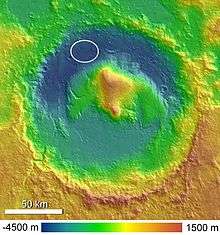
Gale crater, named for Walter F. Gale (1865-1945), an amateur astronomer from Australia, spans 154 km (96 mi) in diameter and holds a mountain, Aeolis Mons (informally named "Mount Sharp" to pay tribute to geologist Robert P. Sharp) rising 18,000 ft (5,500 m) from the crater floor, higher than Mount Rainier rises above Seattle. Gale is roughly the size of Connecticut and Rhode Island.
The crater formed when a meteor hit Mars in its early history, about 3.5 to 3.8 billion years ago. The meteor impact punched a hole in the terrain, and the subsequent explosion ejected rocks and soil that landed around the crater. Layering in the central mound (Aeolis Mons) suggests it is the surviving remnant of an extensive sequence of deposits. Some scientists believe the crater filled in with sediments and, over time, the relentless Martian winds carved Aeolis Mons, which today rises about 5.5 km (3.4 mi) above the floor of Gale—three times higher than the Grand Canyon is deep.[17]
At 10:32 p.m. PDT on Aug. 5, 2012 (1:32 a.m. EDT on Aug. 6, 2012), the Mars Science Laboratory rover, Curiosity, landed on Mars at 4°30′S 137°24′E / 4.5°S 137.4°E, at the foot of the layered mountain inside Gale crater. Curiosity landed within a landing ellipse approximately 7 km (4.3 mi) by 20 km (12 mi). The landing ellipse is about 4,400 m (14,400 ft) below Martian "sea level" (defined as the average elevation around the equator). The expected near-surface atmospheric temperatures at the landing site during Curiosity's primary mission (1 Martian year or 687 Earth days) are from −90 °C (−130 °F) to 0 °C (32 °F).
Scientists chose Gale as the landing site for Curiosity because it has many signs that water was present over its history. The crater's geology is notable for containing both clays and sulfate minerals, which form in water under different conditions and may also preserve signs of past life. The history of water at Gale, as recorded in its rocks, is giving Curiosity lots of clues to study as it pieces together whether Mars ever could have been a habitat for microbes. Gale Crater contains a number of fans and deltas that provide information about lake levels in the past, including: Pancake Delta, Western Delta, Farah Vallis delta and the Peace Vallis Fan.[18]
Characteristics
An unusual feature of Gale is an enormous mound of "sedimentary debris"[19] around its central peak, officially named Aeolis Mons[5][6] (popularly known as "Mount Sharp"[20][21]) rising 5.5 km (18,000 ft) above the northern crater floor and 4.5 km (15,000 ft) above the southern crater floor - slightly taller than the southern rim of the crater itself. The mound is composed of layered material and may have been laid down over a period of around 2 billion years.[3] The origin of this mound is not known with certainty, but research suggests it is the eroded remnant of sedimentary layers that once filled the crater completely, possibly originally deposited on a lakebed.[3] However, debate exists around this issue.[22][23] Observations of possible cross-bedded strata on the upper mound suggest aeolian processes, but the origin of the lower mound layers remains ambiguous.[24]
Gale is located at about 5°24′S 137°48′E / 5.4°S 137.8°E on Mars.[25]
Spacecraft exploration
Numerous channels eroded into the flanks of the crater's central mound could give access to the layers for study.[3] Gale is the landing site of the Curiosity rover, delivered by the Mars Science Laboratory spacecraft,[26] which was launched 26 November 2011 and landed on Mars at Gale crater on the plains of Aeolis Palus[27] on 6 August 2012.[28][29][30][31] Gale was previously a candidate landing site for the 2003 Mars Exploration Rover mission, and has been one of four prospective sites for ESA's ExoMars.[32]
In December 2012, scientists working on the Mars Science Laboratory mission announced that an extensive soil analysis of Martian soil performed by Curiosity showed evidence of water molecules, sulphur and chlorine, as well as hints of organic compounds.[33][34][35] However, terrestrial contamination, as the source of the organic compounds, could not be ruled out.
On September 26, 2013, NASA scientists reported that Curiosity detected "abundant, easily accessible" water (1.5 to 3 weight percent) in soil samples at the Rocknest region of Aeolis Palus in Gale.[36][37][38][39][40][41] In addition, the rover found two principal soil types: a fine-grained mafic type and a locally derived, coarse-grained felsic type.[38][40][42] The mafic type, similar to other martian soils and martian dust, was associated with hydration of the amorphous phases of the soil.[42] Also, perchlorates, the presence of which may make detection of life-related organic molecules difficult, were found at the Curiosity landing site (and earlier at the more polar site of the Phoenix lander) suggesting a "global distribution of these salts".[41] NASA also reported that Jake M rock, a rock encountered by Curiosity on the way to Glenelg, was a mugearite and very similar to terrestrial mugearite rocks.[43]
On December 9, 2013, NASA reported that, based on evidence from Curiosity studying Aeolis Palus, Gale contained an ancient freshwater lake which could have been a hospitable environment for microbial life.[44][45]
On December 16, 2014, NASA reported detecting, by the Curiosity rover at Gale Crater, an unusual increase, then decrease, in the amounts of methane in the atmosphere of the planet Mars; in addition, organic chemicals were detected in powder drilled from a rock. Also, based on deuterium to hydrogen ratio studies, much of the water at Gale Crater on Mars was found to have been lost during ancient times, before the lakebed in the crater was formed; afterwards, large amounts of water continued to be lost.[46][47][48]
On October 8, 2015, NASA confirmed that lakes and streams existed in Gale crater 3.3 - 3.8 billion years ago delivering sediments to build up the lower layers of Mount Sharp.[49][50]
Images
 Mars between day and night, with an area containing Gale crater, beginning to catch the morning light.
Mars between day and night, with an area containing Gale crater, beginning to catch the morning light. Maps of Mars - old and new - Gale is noted in the middle of the image.
Maps of Mars - old and new - Gale is noted in the middle of the image. Map of actual (and proposed) rover landing sites including Gale.
Map of actual (and proposed) rover landing sites including Gale.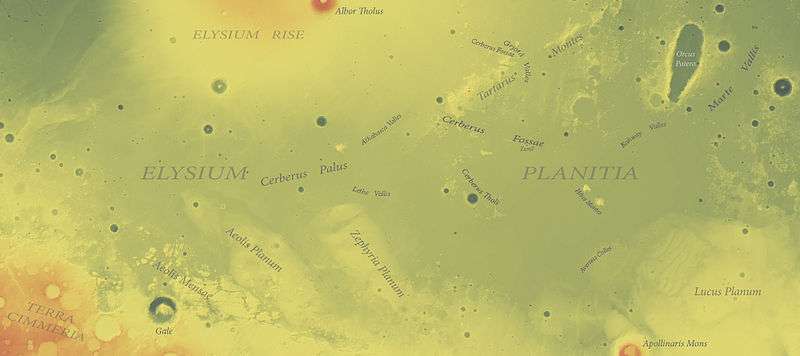 Map of Elysium Planitia - Gale is in the lower left - Aeolis Mons is in the middle of the crater.
Map of Elysium Planitia - Gale is in the lower left - Aeolis Mons is in the middle of the crater.- Map of Aeolis quadrangle - Gale is in the upper left - Aeolis Mons is in the middle of the crater.
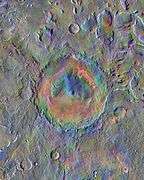 Gale crater - surface materials (false colors; THEMIS; 2001 Mars Odyssey).
Gale crater - surface materials (false colors; THEMIS; 2001 Mars Odyssey).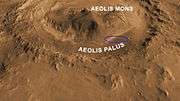 Gale crater landing site is within Aeolis Palus near Aeolis Mons - north is down.
Gale crater landing site is within Aeolis Palus near Aeolis Mons - north is down.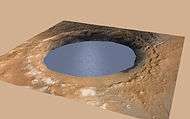 Ancient Lake fills Gale Crater on Mars (simulated view).
Ancient Lake fills Gale Crater on Mars (simulated view).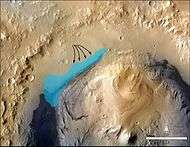
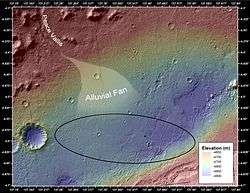
.jpg) Gale crater - landing site is noted - also, alluvial fan (blue) and sediment layers in Aeolis Mons (cutaway).
Gale crater - landing site is noted - also, alluvial fan (blue) and sediment layers in Aeolis Mons (cutaway).
 Aeolis Mons may have formed from the erosion of sediment layers that once filled Gale.
Aeolis Mons may have formed from the erosion of sediment layers that once filled Gale.- Gale sediment layers may have formed by lake or windblown particle deposition.
- Gale's 'Grand Canyon', as seen by HiRISE - Scale bar is 500 meters long.
 Curiosity landing site (green dot) - blue dot marks "Glenelg Intrigue" - blue spot marks base of Aeolis Mons - a planned area of study.
Curiosity landing site (green dot) - blue dot marks "Glenelg Intrigue" - blue spot marks base of Aeolis Mons - a planned area of study. Curiosity landing site -"quad map" includes "Yellowknife" Quad 51 of Aeolis Palus in Gale crater.
Curiosity landing site -"quad map" includes "Yellowknife" Quad 51 of Aeolis Palus in Gale crater.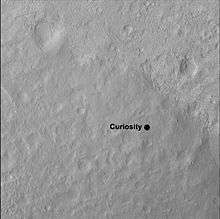 Curiosity landing site - "Yellowknife" Quad 51 (1-mi-by-1-mi) of Aeolis Palus in Gale.
Curiosity landing site - "Yellowknife" Quad 51 (1-mi-by-1-mi) of Aeolis Palus in Gale.
_-_HiRISE_-_20120814.jpg)
 First-year and first-mile traverse map of Curiosity on Mars (August 1, 2013) (3-D).
First-year and first-mile traverse map of Curiosity on Mars (August 1, 2013) (3-D). Sunset - Gale crater (April 15, 2015).
Sunset - Gale crater (April 15, 2015).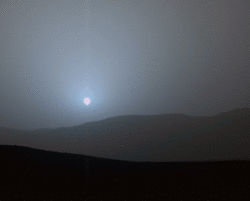 Sunset (animated) - Gale crater (April 15, 2015).
Sunset (animated) - Gale crater (April 15, 2015).
Surface images

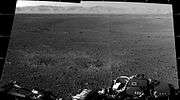 Gale crater rim and floor as viewed by Curiosity (August 9, 2012).
Gale crater rim and floor as viewed by Curiosity (August 9, 2012).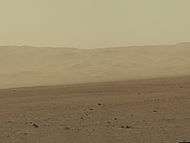 Gale rim about 18 km (11 mi) north of Curiosity (August 9, 2012).
Gale rim about 18 km (11 mi) north of Curiosity (August 9, 2012). Layers at the base of Aeolis Mons - dark rock in inset is same size as Curiosity (white balanced image).
Layers at the base of Aeolis Mons - dark rock in inset is same size as Curiosity (white balanced image).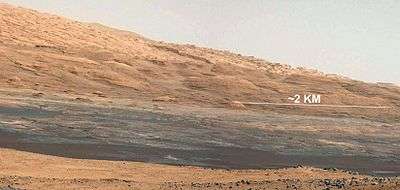 Aeolis Mons in Gale as viewed by Curiosity (August 9, 2012) (white balanced image).
Aeolis Mons in Gale as viewed by Curiosity (August 9, 2012) (white balanced image).
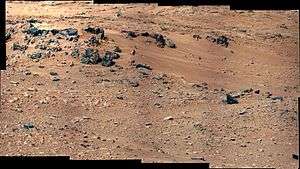

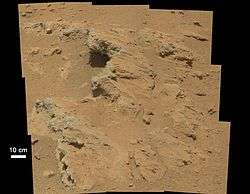




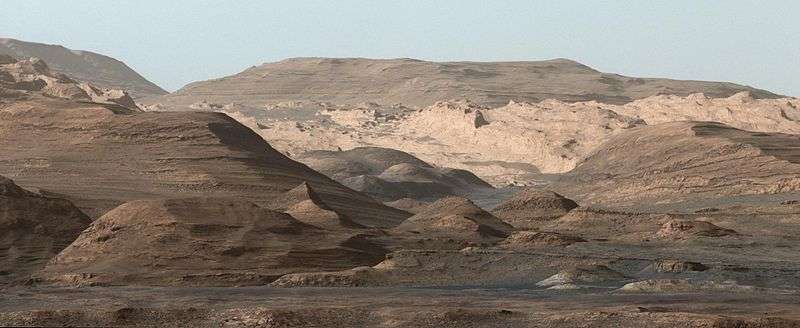
See also
- Astrobiology
- Atmosphere of Mars
- Composition of Mars
- Equatorial Layered Deposits
- Geology of Mars
- Glenelg, Mars
- Groundwater on Mars
- Lakes on Mars
- Life on Mars
- List of mountains on Mars
- List of mountains on Mars by height
- List of rocks on Mars
- List of valles on Mars
- Peace Vallis
- Timeline of Mars Science Laboratory
- Water on Mars
References
- 1 2 "NASA's Next Mars Rover to Land at Gale Crater". NASA. July 22, 2011. Retrieved 2012-08-18.
- ↑ USGS Gazetteer of Planetary Nomenclature. http://planetarynames.wr.usgs.gov/nomenclature/Feature/2071.
- 1 2 3 4 "Mars Odyssey Mission THEMIS: Gale Crater's History Book". ASU.edu. Retrieved 2012-08-18.
- ↑ Wood, Harley. "Biography - Walter Frederick Gale". ADB.anu.edu.au. Australian Dictionary of Biography. Retrieved 2012-08-18.
- 1 2 3 USGS (16 May 2012). "Three New Names Approved for Features on Mars". USGS. Retrieved 2012-05-28.
- 1 2 3 IAU (16 May 2012). "Planetary Names: Mons, montes: Aeolis Mons on Mars". USGS. Retrieved 2012-05-28.
- ↑ IAU Staff (September 26, 2012). "Gazeteer of Planetary Nomenclature: Peace Vallis". IAU. Retrieved September 28, 2012.
- 1 2 Brown, Dwayne; Cole, Steve; Webster, Guy; Agle, D.C. (September 27, 2012). "NASA Rover Finds Old Streambed On Martian Surface". NASA. Retrieved September 28, 2012.
- 1 2 NASA (September 27, 2012). "NASA's Curiosity Rover Finds Old Streambed on Mars - video (51:40)". NASAtelevision. Retrieved September 28, 2012.
- 1 2 Chang, Alicia (September 27, 2012). "Mars rover Curiosity finds signs of ancient stream". AP News. Retrieved September 27, 2012.
- ↑ NASA Staff (August 10, 2012). "Curiosity's Quad - IMAGE". NASA. Retrieved August 11, 2012.
- ↑ Agle, DC; Webster, Guy; Brown, Dwayne (August 9, 2012). "NASA's Curiosity Beams Back a Color 360 of Gale Crate". NASA. Retrieved August 11, 2012.
- ↑ Amos, Jonathan (August 9, 2012). "Mars rover makes first colour panorama". BBC News. Retrieved August 9, 2012.
- ↑ Halvorson, Todd (August 9, 2012). "Quad 51: Name of Mars base evokes rich parallels on Earth". USA Today. Retrieved August 12, 2012.
- ↑ Steve Gorman & Irene Klotz (6 August 2012). "NASA rover Curiosity makes historic Mars landing, beams back photos'". Reuters. Retrieved 6 August 2012.
- ↑ Brown, Dwayne; Cole, Steve; Webster, Guy; Agle, D.C. (August 22, 2012). "NASA Mars Rover Begins Driving at Bradbury Landing". NASA. Retrieved August 22, 2012.
- ↑ Jet Propulsion Laboratory. "Mars Science Laboratory: Curiosity's Landing Site: Gale Crater". NASA. Retrieved 2012-08-18.
- ↑ Dietrich, W. E.; Palucis, M. C.; Parker, T.; Rubin, D.; Lewis, K.; Sumner, D.; Williams, R.M.E. (2014). Clues to the relative timing of lakes in Gale Crater (PDF) (Report). Eighth International Conference on Mars (2014).
- ↑ Staff. "The Mound In Gale Crater". NASA. Retrieved January 5, 2013.
- ↑ NASA Staff (27 March 2012). "'Mount Sharp' on Mars Compared to Three Big Mountains on Earth". NASA. Retrieved 31 March 2012.
- ↑ Agle, D. C. (28 March 2012). "'Mount Sharp' On Mars Links Geology's Past and Future". NASA. Retrieved 31 March 2012.
- ↑ Cabrol, N. A.; Grin, E. A.; Newsom, H. E.; Landheim, R.; McKay, C. P. (June 1999). "Hydrogeologic evolution of Gale Crater and its relevance in the exobiological exploration of Mars" (PDF). Icarus. 139 (2): 235–245. Bibcode:1999Icar..139..235C. doi:10.1006/icar.1999.6099. Retrieved 2012-08-01.
- ↑ Irwin, R. P.; Howard, A. D.; Craddock, R. A.; Moore, J. M. (2005). "An intense terminal epoch of widespread fluvial activity on early Mars: 2. Increased runoff and paleolake development". Journal of Geophysical Research. 110: E12S15. Bibcode:2005JGRE..11012S15I. doi:10.1029/2005JE002460. Retrieved 2012-08-01.
- ↑ Anderson, Ryan B.; Bell, James F., III (2010). "Geologic mapping and characterization of Gale Crater and implications for its potential as a Mars Science Laboratory landing site". The Mars Journal. 5: 76–128. Bibcode:2010IJMSE...5...76A. doi:10.1555/mars.2010.0004. doi:10.1555/mars.2010.0004
- ↑ "Gale crater". Google Mars. Google. Retrieved 2012-08-18.
- ↑ The Associated Press (26 November 2011). "NASA Launches Sophisticated Rover on Journey to Mars". The New York Times. Retrieved 26 November 2011.
- ↑ IAU (16 May 2012). "Planetary Names: Palus, paludes: Aeolis Palus on Mars". USGS. Retrieved 2012-05-28.
- ↑ "Geometry Drives Selection Date for 2011 Mars Launch". News and Features. NASA/JPL-Caltech.
- ↑ Webster, Guy; Brown, Dwayne (22 July 2011). "NASA's Next Mars Rover To Land At Gale Crater". NASA JPL. Retrieved 2011-07-22.
- ↑ Chow, Denise (22 July 2011). "NASA's Next Mars Rover to Land at Huge Gale Crater". Space.com. Retrieved 2011-07-22.
- ↑ Amos, Jonathan (22 July 2011). "Mars rover aims for deep crater". BBC News. Retrieved 2011-07-22.
- ↑ "Mars landing sites down to final four". World News (WN) Network.
- ↑ Brown, Dwayne; Webster, Guy; Neal-Jones, Nancy (December 3, 3012). "NASA Mars Rover Fully Analyzes First Martian Soil Samples". NASA. Retrieved December 3, 2012. Check date values in:
|date=(help) - ↑ Chang, Ken (December 3, 2012). "Mars Rover Discovery Revealed". New York Times. Retrieved December 3, 2012.
- ↑ Satherley, Dan (December 4, 2012). "'Complex chemistry' found on Mars". 3 News. Retrieved December 4, 2012.
- ↑ Lieberman, Josh (September 26, 2013). "Mars Water Found: Curiosity Rover Uncovers 'Abundant, Easily Accessible' Water In Martian Soil". iSciencetimes. Retrieved September 26, 2013.
- ↑ Leshin, L. A.; et al. (September 27, 2013). "Volatile, Isotope, and Organic Analysis of Martian Fines with the Mars Curiosity Rover". Science. 341 (6153): 1238937. doi:10.1126/science.1238937. Retrieved September 26, 2013.
- 1 2 Grotzinger, John (September 26, 2013). "Introduction To Special Issue: Analysis of Surface Materials by the Curiosity Mars Rover". Science. 341 (6153): 1475. Bibcode:2013Sci...341.1475G. doi:10.1126/science.1244258. Retrieved September 27, 2013.
- ↑ Neal-Jones, Nancy; Zubritsky, Elizabeth; Webster, Guy; Martialay, Mary (September 26, 2013). "Curiosity's SAM Instrument Finds Water and More in Surface Sample". NASA. Retrieved September 27, 2013.
- 1 2 Webster, Guy; Brown, Dwayne (September 26, 2013). "Science Gains From Diverse Landing Area of Curiosity". NASA. Retrieved September 27, 2013.
- 1 2 Chang, Kenneth (October 1, 2013). "Hitting Pay Dirt on Mars". New York Times. Retrieved October 2, 2013.
- 1 2 Meslin, P.-Y.; et al. (September 26, 2013). "Soil Diversity and Hydration as Observed by ChemCam at Gale Crater, Mars". Science. 341 (6153): 1238670. doi:10.1126/science.1238670. Retrieved September 27, 2013.
- ↑ Stolper, E.M.; Baker, M.B.; Newcombe, M.E.; Schmidt, M.E.; Treiman, A.H.; Cousin, A.; Dyar, M.D.; Fisk, M.R.; et al. "The Petrochemistry of Jake_M: A Martian Mugearite". Science. AAAS. 341 (6153): 1239463. doi:10.1126/science.1239463. Retrieved September 28, 2013.
- 1 2 Chang, Kenneth (December 9, 2013). "On Mars, an Ancient Lake and Perhaps Life". New York Times. Retrieved December 9, 2013.
- 1 2 Various (December 9, 2013). "Science - Special Collection - Curiosity Rover on Mars". Science. Retrieved December 9, 2013.
- ↑ Webster, Guy; Neal-Jones, Nancy; Brown, Dwayne (December 16, 2014). "NASA Rover Finds Active and Ancient Organic Chemistry on Mars". NASA. Retrieved December 16, 2014.
- ↑ Chang, Kenneth (December 16, 2014). "'A Great Moment': Rover Finds Clue That Mars May Harbor Life". New York Times. Retrieved December 16, 2014.
- ↑ Mahaffy, P.R.; et al. (December 16, 2014). "Mars Atmosphere - The imprint of atmospheric evolution in the D/H of Hesperian clay minerals on Mars". Science. 347: 412–414. Bibcode:2015Sci...347..412M. doi:10.1126/science.1260291. Retrieved December 16, 2014.
- ↑ Clavin, Whitney (October 8, 2015). "NASA's Curiosity Rover Team Confirms Ancient Lakes on Mars". NASA. Retrieved October 9, 2015.
- ↑ Grotzinger, J.P.; et al. (October 9, 2015). "Deposition, exhumation, and paleoclimate of an ancient lake deposit, Gale crater, Mars". Science. 350 (6257): aac7575. Bibcode:2015Sci...350.7575G. doi:10.1126/science.aac7575. Retrieved October 9, 2015.
- ↑ Mars Science Laboratory: Multimedia-Images
External links
| Wikimedia Commons has media related to Gale Crater. |
- Google Mars scrollable map - centered on Gale Crater.
- Gale Crater - Curiosity Rover "StreetView" (Sol 2 - 08/08/2012) - NASA/JPL - 360° Panorama from 360pano.eu
- Gale Crater - Curiosity Rover Landing Site (07/21/2012) – Video (02:37) on YouTube
- Gale Crater - Central Debris Mound from lpl.arizona.edu
- Gale Crater - Layers from lpl.arizona.edu
- Gale Crater - Image/THEMIS VIS 18m/px Mosaic from mars.asu.edu (Zoomable) (small)
- Gale Crater - Surroundings from HRSCview.fu-berlin.de
- Gale Crater - 3D version by ESA
- Video (04:32) - Evidence: Water "Vigorously" Flowed On Mars - September, 2012
- -- Lakes, Fans, Deltas and Streams: Geomorphic Constraints ...


